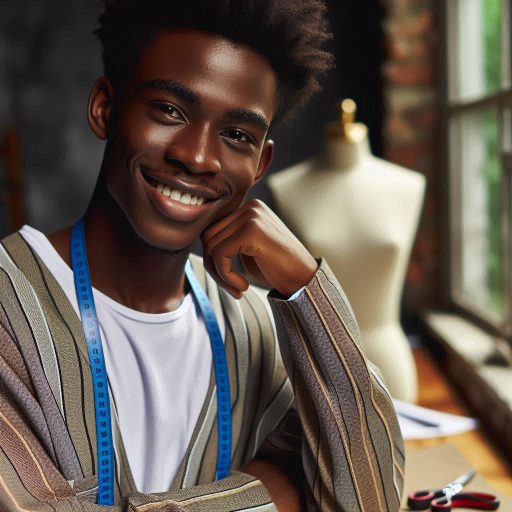Introduction
Costume design plays a crucial role in both theater and film, shaping characters and enhancing storytelling.
In both mediums, costume designers create looks that reflect the character‘s personality, time period, and social status.
However, the approaches to costume design differ significantly between theater and film.
In theater, costume designers craft costumes with the live audience in mind.
They often use bold colors, exaggerated styles, and durable materials to ensure costumes remain visible and impactful, even from a distance.
The costumes must also withstand the physical demands of live performances, allowing actors to move freely while maintaining the character‘s visual integrity.
Film, on the other hand, requires more attention to subtle details and realism.
Costume designers must consider close-up shots, which reveal intricate textures and fabric choices.
Film costumes are typically more nuanced, using naturalistic fabrics and precise tailoring to enhance authenticity.
Additionally, costumes in film often reflect the character‘s development over time, as scenes are shot out of sequence.
Ultimately, the main difference between the two lies in the way costumes are viewed by the audience: theater requires broad strokes for impact, while film demands fine-tuned details for realism.
Historical perspective
Evolution of costume design in theater
In the early days of theater, costumes were simple and mostly consisted of robes, tunics, and masks.
They were designed to help the audience differentiate between characters.
As theater evolved over time, costume design became more elaborate and detailed, reflecting the changing tastes and styles of different time periods.
Key moments in the history of costume design in film
Costume design in film started to gain importance in the early 20th century with the rise of silent films.
Costume designers like Edith Head and Travis Banton became influential figures in Hollywood, creating iconic looks for movie stars.
The Golden Age of Hollywood in the 1930s and 1940s brought about glamorous and extravagant costumes that captured the imagination of audiences worldwide.
The 1960s and 1970s saw a shift towards more naturalistic and contemporary costume designs, reflecting the changing social and cultural norms of the time.
Influences of different time periods on costume design in theater and film
Costume design in theater and film has been influenced by various time periods throughout history.
For example, the Elizabethan era inspired elaborate and ornate costumes with ruffled collars and puffy sleeves in both theater and film.
Transform Your Career Today
Unlock a personalized career strategy that drives real results. Get tailored advice and a roadmap designed just for you.
Start NowThe Art Deco movement of the 1920s and 1930s influenced sleek and modern costume designs in both mediums.
The retro aesthetic of the 1980s has made a comeback in recent years, with bold colors and exaggerated silhouettes being prominent in both theater and film.
In fact, costume design in theater and film has evolved significantly over time, reflecting the changing tastes and styles of different time periods.
Both mediums have been influenced by historical events, cultural movements, and societal norms, resulting in a diverse range of costumes that add depth and authenticity to the characters and stories being portrayed.
Read: Budgeting for a Costume Design Project
Budget considerations
When it comes to costume design for theater versus film, one of the most significant factors to consider is budget constraints.
Budget limitations can greatly influence the choices made in costume design and have a profound impact on the overall creative process.
How budget constraints influence costume design choices in theater
- Limited resources: Theater productions often have smaller budgets compared to film, which means costume designers have to be resourceful and creative in their approach.
- Repurposing: Due to budget constraints, costume designers in theater may need to repurpose or recycle existing costumes to fit the needs of the production.
- Prioritizing essentials: With a limited budget, theater costume designers must prioritize essential costumes that have the most impact on the overall production.
- DIY approach: Theater costume designers often have to adopt a do-it-yourself approach to costume creation, using cost-effective materials and techniques.
How the budget for costume design in film differs from that in theater
- Larger budgets: Films generally have larger budgets allocated for costume design, allowing for more elaborate and detailed costumes.
- Higher production values: The higher budget in film production enables costume designers to work with luxurious fabrics, intricate designs, and custom-made pieces.
- Access to resources: Film costume designers have easier access to a wide range of resources, from professional tailors to high-end costume shops.
- Scale of production: Film productions often involve larger casts and more intricate costume requirements, necessitating a larger budget for costume design.
Impact of budget limitations on the overall creative process of costume design
- Creativity under constraints: Budget limitations in both theater and film can inspire costume designers to think outside the box and come up with innovative solutions.
- Collaboration and compromise: Tight budgets often require collaboration between costume designers, directors, and producers to find cost-effective solutions without compromising artistic vision.
- Time constraints: Working within a limited budget may impose time constraints on costume designers, requiring quick decision-making and efficient use of resources.
- Innovation and uniqueness: Despite budget limitations, costume designers can still create impactful and memorable costumes by finding innovative ways to work within their financial constraints.
In essence, while budget constraints may pose challenges for costume designers in both theater and film, they can also spark creativity, collaboration, and innovation in the costume design process, resulting in unique and impactful costumes that enhance the overall production.
Read: Pathway to Becoming a Successful Art Instructor
Collaborative Process
Costume design is a crucial aspect of both theater and film production, requiring collaboration among various individuals to bring the vision to life.
Collaborative Nature of Costume Design in Theater
Costume designers work closely with the director to understand the overall vision of the production.
They collaborate with actors to ensure that costumes reflect the characters’ personalities and motivations.
Costume designers also liaise with other departments, such as set design, to create a cohesive visual aesthetic.
Throughout the process, feedback and input from all parties involved are essential to achieving a unified look on stage.
Role of Costume Designers, Directors, and Actors in the Creative Process
Costume designers are responsible for translating the director’s vision into tangible costumes that enhance the storytelling.
Directors provide guidance on character development, setting the tone for the overall production through costume choices.
Actors bring characters to life through their performances, relying on costumes to help them embody their roles authentically.
Together, these individuals collaborate to ensure that costumes not only look good but also serve the narrative effectively.
Comparing the Collaborative Process of Costume Design in Film with That of Theater
In film, costume designers work closely with the director and cinematographer to create costumes that look good on camera.
Showcase Your Business Today
Reach thousands of readers actively exploring professional services. Publish your business profile and grow your audience now.
Publish NowUnlike theater, where costumes need to be visually striking from a distance, film costumes must withstand close-up scrutiny.
While actors still play a crucial role in bringing characters to life, the camera often dictates costume choices in film production.
Overall, the collaborative process in film tends to be more focused on visual aesthetics and technical considerations compared to theater.
In short, costume design in both theater and film is a collaborative effort that requires effective communication, creativity, and attention to detail to bring characters and stories to life on stage and screen.
Read: How to Get Costume Design Internships

Technology and practicality
How advancements in technology have influenced costume design in film
Advancements in technology have revolutionized costume design in film, allowing for more intricate and elaborate designs.
CGI and computer-aided design tools make it possible to create fantastical costumes that would be impossible using traditional methods.
Costume designers in film have access to cutting-edge materials and techniques, such as 3D printing and digital embroidery, which can bring their visions to life in ways that were previously unimaginable.
The use of green screens and motion capture technology also allows for costumes to be enhanced or entirely replaced in post-production, giving filmmakers greater flexibility in creating their desired aesthetic.
However, despite these advancements, practical considerations still play a significant role in costume design for film.
Costumes must be durable, comfortable for actors to wear for long periods, and able to withstand the demands of filming.
Practical considerations that come into play when designing costumes for theater
On the other hand, designing costumes for theater requires a different approach.
While technology has started to play a role in some theatrical productions, practicality remains a key consideration due to the live nature of theater performances.
In theater, costumes must not only look impressive but also allow actors to move freely and change quickly between scenes.
This often means prioritizing comfort, ease of movement, and durability over elaborate designs.
Unlike in film, where costumes can be pieced together in post-production, theater costumes need to be meticulously crafted to withstand multiple performances without falling apart or losing their visual impact.
Additionally, budget constraints are often a more significant factor in theater costume design, as productions have limited resources compared to big-budget films.
Designers must find creative ways to achieve their vision within these constraints.
Comparing the use of technology in costume design between theater and film
Overall, while technology has transformed costume design in both theater and film, the ways in which it is utilized differ significantly between the two mediums.
Film costume designers have the luxury of advanced tools and resources that allow them to create visually stunning costumes that push the boundaries of imagination.
However, they must still ensure that these designs are practical for filming purposes.
In contrast, theater costume designers must balance creativity with practicality, creating costumes that not only look impressive on stage but also withstand the rigors of live performance.
Technology is used more sparingly and usually only to enhance, rather than replace, traditional costume-making techniques.
In general, while technology plays a vital role in costume design for both theater and film, the practical considerations and artistic goals of each medium shape how these tools are utilized.
Whether creating larger-than-life costumes for the big screen or functional yet visually striking designs for the stage, costume designers must navigate the intersection of technology and practicality to bring their creations to life.
Read: Top Skills Needed for Art Educators and Instructors
Audience perspective
From an audience perspective, costume design plays a crucial role in shaping the overall experience in both theater and film.
Let’s delve into how costumes contribute to the audience’s immersion in the world of storytelling.
Theater Audience Experience
Costumes in theater help audiences suspend disbelief and transport them to different time periods or fantastical worlds.
The intricacy and detail of theater costumes can enhance the audience’s connection to characters and the story.
Theater audiences appreciate the craftsmanship and artistry behind the creation of costumes, adding to their overall enjoyment.
Costumes are essential in defining characters on stage, helping audiences understand personalities, social status, and relationships.
Theater audiences expect costumes to be visually captivating and to complement the setting and atmosphere of the production.
Significance of Costumes in Film
In film, costumes are critical in creating authentic and believable characters that resonate with audiences.
Costumes in film serve as visual storytelling tools, conveying information about characters’ backgrounds, personalities, and motivations.
Costume designers in films meticulously research and collaborate with directors to ensure costumes align with the narrative and character development.
Film audiences expect costumes to be realistic and consistent with the film’s setting, time period, and overall aesthetic.
Well-designed costumes in film can elevate the viewing experience by immersing audiences in the story’s world and enhancing emotional connections.
Audience Expectations: Theater vs. Film
Theater audiences appreciate the live element of costume design, witnessing the transformation of actors on stage.
Film audiences expect seamless continuity in costumes, as they can scrutinize details in close-up shots and different scenes.
Showcase Your Business Today
Reach thousands of readers actively exploring professional services. Publish your business profile and grow your audience now.
Publish NowTheater audiences are drawn to the artistry and larger-than-life nature of costumes, adding to the theatrical experience.
Film audiences focus on how costumes contribute to character development and storytelling, with attention to authenticity and detail.
Both theater and film audiences value costumes that enhance performances and contribute to the overall visual storytelling of the production.
In review, whether in theater or film, costume design is an integral aspect of storytelling that deeply impacts the audience experience.
From defining characters to setting the tone of a production, costumes play a vital role in engaging and captivating audiences in different ways.
Discover More: Typography in Film: Iconic Movie Titles
Cultural and Historical Accuracy
In theater, cultural and historical accuracy is crucial for setting the tone of the production.
This accuracy helps transport the audience to a specific time and place, enhancing the overall experience.
The costume designer must research the era and culture extensively to ensure authenticity in every detail.
From fabrics and colors to styles and accessories, each element must reflect the time period accurately.
This attention to detail in theater costumes helps create a believable world on stage for the audience.
Historical accuracy also plays a significant role in the storytelling process, reinforcing the narrative and characters.
Importance of Cultural and Historical Accuracy in Theater Costume Design
Theater costume designers rely on historical research and cultural awareness to bring characters to life.
By accurately representing the time and place of the story, costumes help ground the characters in reality.
Audience members can better connect with the characters when their costumes reflect the cultural norms of the era.
Theater productions set in specific historical periods require a deep understanding of fashion and societal conventions.
Costume designers often collaborate with historians and researchers to ensure accuracy in their designs.
The goal is to transport the audience to a different time and place through the costumes.
Striving for Authenticity in Historical and Culturally Specific Films
In film, costume designers face similar challenges when creating costumes for historical and culturally specific movies.
The goal is to transport viewers to a different time and place seamlessly through the characters’ clothing.
A great deal of research and attention to detail goes into creating costumes for period films.
The costumes must not only be historically accurate but also visually appealing and reflective of the characters’ personalities.
Film costume designers work closely with directors and production designers to ensure consistency in the overall look of the film.
Historical and culturally specific films rely heavily on costume design to establish the setting and atmosphere.
Approaching Different Cultures and Time Periods in Theater and Film
In theater, representing different cultures and time periods through costume design requires creativity and cultural sensitivity.
Costumes must be carefully researched and designed to accurately portray the diversity of characters on stage.
Theater productions often use symbolism and color to distinguish between different cultures and social classes.
By contrast, film has the advantage of visual storytelling through close-ups and detailed costume shots.
Film costume designers can use a wider range of materials and techniques to create elaborate costumes for diverse characters.
Both theater and film require a deep understanding of historical context and cultural nuances to create authentic costumes.
Conclusion
Costume design for theater and film may have differences in approach, but they share a common goal of enhancing storytelling.
The key differences lie in the importance of details for close-up shots in films, while theaters focus on the overall look from a distance.
Despite these variances, both mediums rely heavily on costume design to transport the audience into the world of the characters.
The choices made by costume designers play a crucial role in setting the tone, time period, and character development in both theater and film.
Costume design not only adds visual appeal but also assists in character development, creating a more immersive experience for the audience.
It helps convey the social status, personality, and emotional journey of the characters without the need for extensive dialogue.
Aspiring costume designers and enthusiasts should further explore the intricacies of costume design in both theater and film to gain a deeper understanding of how this art form contributes to the overall storytelling process.
By studying successful examples and experimenting with different techniques, one can truly appreciate the impact that costume design has on the audience’s perception of the characters and narrative.
[E-Books for Sale]
The Big Book of 500 High-Paying Jobs in America: Unlock Your Earning Potential
$19.99 • 500 High-Paying Jobs • 330 pages
Explore 500 high-paying jobs in America and learn how to boost your career, earn more, and achieve success!
See All 500 High-Paying Jobs of this E-Book
1001 Professions Without a Degree: High-Paying American Jobs You Can Start Now
$19.99 • 1001 Professions Without a Degree • 174 pages
Discover 1001 high-paying jobs without a degree! Unlock career tips, skills, and success strategies for just $19.99!




